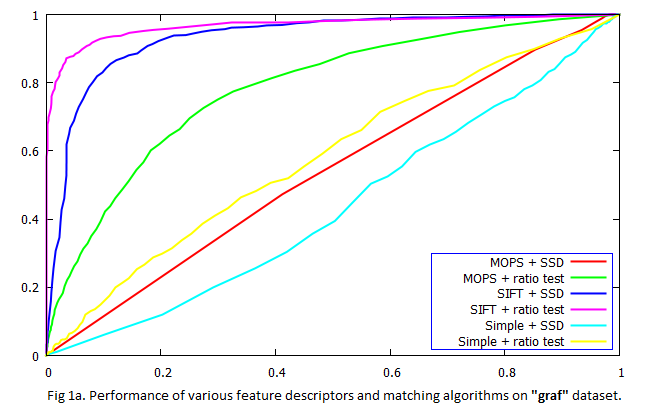Throughout the whole assignment, I had to deal with the Accuracy-Runtime trade-off. For example, while calculating the local maxima of harris points, I only chose those points that are above a particular threshold. If this threshold is too low, then I have to deal with a lot of harris points which increases runtime. However, the more the number of harris points, the more the matching accuracy. So, I chose a threshold which maintains a good balance between accuracy and runtime.
Another major design issue was the feature descriptor algorithm. I tried scaling the 40x40 window into multiple sizes and stack them one after another as a pyramid. However, it increases the runtime hugely. Therefore, I scaled it to one size (8x8) and it worked well with a reasonable runtime.
Performance
Performances (in terms of ROC curve) of different feature descriptors and matching algorithms on two benchmark datasets are given below (Figure 1a and 1b). X-axis is the FP rate and Y-axis is the TP-rate. As expected, "MOPS + Ratio test" does the best job on both datasets. Using this, we can select a reasonably well threshold which gives a good TP rate with relatively low FP rate.


Another way of choosing threshold is to plot the (TP rate - FP rate) Vs Threshold (Figure 2a and 2b). Using this plots, we can select the X-value of the peak as a good measure of the threshold.


Performance of two descriptors (Simple and MOPS) with two different matching approaches (SSD and Ratio) on all the benchmark datasets are given below in Table 1.
| Bikes | Graf | Leuven | Wall | |||||
| Average Pixel Error | Average AUC | Average Pixel Error | Average AUC | Average Pixel Error | Average Error | Average Pixel Error | Average AUC | |
| MOPS + Ratio | 389.26 | 0.77 | 268.92 | 0.70 | 160.45 | 0.85 | 295.42 | 0.85 |
| MOPS + SSD | 389.26 | 0.58 | 268.92 | 0.48 | 160.45 | 0.60 | 295.42 | 0.54 |
| Simple + Ratio | 397.63 | 0.46 | 313.00 | 0.56 | 383.09 | 0.53 | 382.46 | 0.61 |
| Simple + SSD | 397.63 | 0.23 | 313.00 | 0.45 | 383.09 | 0.08 | 382.46 | 0.23 |
Table 1: Performace on all the benchmark datasets.
Harris Images
These are the sample harris images of two benchmark images. To get a good brightness, original pixel values are multiplied by 1000 here.



